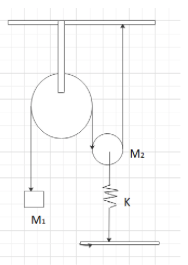Question
Question: What would be the period of the free oscillations of the system shown here if mass \[{M_1}\] is pull...
What would be the period of the free oscillations of the system shown here if mass M1 is pulled down a little? Force constant of the spring isk, the mass of fixed pulley is negligible and movable pulley is smooth

A)T=2πkM1+M2
B)T=2πkM1+4M2
C) T=2πkM2+4M1
D)T=2πkM2+3M1
Solution
In this question, we can calculate the force equations for both masses. After that we can use both equations and deduce them in one equation. We have to simplify the equation to form the equation of SHM. After comparing this equation with the standard equation, we can find the expression for frequency.
Complete step by step solution: -
Let the system spring extended by xat equilibrium position. Then in this position the tension of mass M1is T′and mass M2(pulley) be 2T′.
So, we have force equation as for the both masses-
ForM1, T=M1g
And forM2, kx0=2T−M2g.................(i)
Now consider displacement of mass M2displaced byx. The corresponding displacement for mass of block M1is2x. And in this position tension on M1be T′′ and on M2be 2T′′.
So, forM2,
M2dt2d2x=2T′′−M2g−kx−kx0................(ii)
For M1
M1dt2d2(2x)=M1g−T′′.........................(iii)
Multiplying equation (iii) by 2and adding it with equation (ii), we get
(M2+4M1)dt2d2x=2M1g−M2g−kx−kx0
Putting the value ofkx0, we get-
Comparing this equation with dt2d2x+ωx=0, we get-
Angular frequency, ω=M2+4M1k
We know that the time period, T=ω2π
Putting the value ofω, we get-
Therefore, option C is correct.
Note: - In this question, we have to remember that the force equations for both masses are different for the first mass there is no spring so the equation does not have a spring constant. While for the second mass the spring is attached so the spring constant part will be in the equation. We have to try to deduce the equation in such a way that the final equation will be in the form of dt2d2x+ωx=0.
